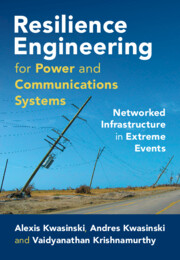 Resilience Engineering for Power and Communications Systems
Resilience Engineering for Power and Communications Systems Book contents
- Resilience Engineering for Power and Communications Systems
- Resilience Engineering for Power and Communications Systems
- Copyright page
- Contents
- Preface
- Acknowledgments
- 1 Introduction
- 2 Fundamental Supporting Concepts
- 3 Resilience Models and Metrics
- 4 Dependencies and Interdependencies and Their Effect on Resilience
- 5 Disaster Forensics of Infrastructure Systems
- 6 Electric Power Grid Resilience
- 7 Resilience of Information and Communication Networks
- 8 Integrated Electric Power and Communications Infrastructure Resilience
- 9 Infrastructure Systems Planning for Improved Resilience
- Index
- References
9 - Infrastructure Systems Planning for Improved Resilience
Published online by Cambridge University Press: 04 January 2024
- Resilience Engineering for Power and Communications Systems
- Resilience Engineering for Power and Communications Systems
- Copyright page
- Contents
- Preface
- Acknowledgments
- 1 Introduction
- 2 Fundamental Supporting Concepts
- 3 Resilience Models and Metrics
- 4 Dependencies and Interdependencies and Their Effect on Resilience
- 5 Disaster Forensics of Infrastructure Systems
- 6 Electric Power Grid Resilience
- 7 Resilience of Information and Communication Networks
- 8 Integrated Electric Power and Communications Infrastructure Resilience
- 9 Infrastructure Systems Planning for Improved Resilience
- Index
- References
Summary
This chapter explains problems associated with planning infrastructure systems in order to improve resilience. Understanding the concept and basic methods for planning infrastructure investments is an important aspect for studying resilience because planning is a key process that contributes to resilience preparedness and adaptation attributes. Initially, the chapter discusses the fundamental problems and issues found when making decisions about investment allocations amid uncertain conditions. Then, probabilistic risk assessment (PRA) as still the main tool used in industry in planning processes is explained. Because characterizing intensity and other relevant attributes of disruptive events is an important component of planning processes for enhancing resilience, this chapter continues by exploring how these events – and especially hurricanes – can be characterized in order to obtain information that can be used as input for the planning process. Finally, the chapter concludes by discussing economic concepts and tools related to infrastructure resilience enhancement planning processes.
Keywords
- Type
- Chapter
- Information
- Resilience Engineering for Power and Communications SystemsNetworked Infrastructure in Extreme Events, pp. 452 - 485Publisher: Cambridge University PressPrint publication year: 2024


